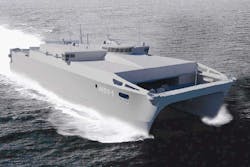Navy eyes autonomous capability for shipboard electronics in Expeditionary Fast Transport vessel
WASHINGTON – U.S. Navy shipboard electronics experts are introducing autonomous capability in the expeditionary fast transport ship, which is designed for rapid intratheater transport of medium-sized cargo payloads.
Officials of the Naval Sea Systems Command in Washington announced a $44 million order Monday to Austal USA in Mobile, Ala., to design, install, and demonstrate autonomous capability in the Expeditionary Fast Transport USNS Apalachicola (T-EPF-13), which is under construction in Mobile, Ala.
The EPF provides high speed, shallow-draft transport capability to move as much as 600 tons of personnel, supplies, and equipment as far as 1,200 nautical miles within military theaters at top speeds between 35 and 45 knots.
Related: Navy ship building and shipboard electronics strive to do more with less
Bridging the gap between slow ships and fast aircraft, the EPF can move loads quickly from ships far offshore to austere, minor, and damaged ports to support the intra-theater maneuver for the Navy, Marine Corps, and Army. Apalachicola will be the thirteenth Spearhead-class expeditionary fast transport.
The EPF normally has a crew of 22 in normal operations, and introducing shipboard electronics autonomy such as unmanned operation or follow capability could enable naval commanders to reduce the number of crew necessary to operate these kinds of vessels. The EPF previously was called the joint high speed vessel (JHSV), but was redesignated in 2015.
The EPF is a shallow-draft, all-aluminum, commercial-based catamaran capable of operating in shallow-draft ports and waterways together with roll-on/roll-off facilities. It can move a combat-loaded M1A2 Abrams main battle tank.
Related: Navy's NIIN aims for single IT shipboard network backbone
The EPF includes a flight deck for helicopters and an off-load ramp that enables vehicles to drive quickly off the ship. The ramp is suitable for the types of austere piers and quay walls common in developing countries.
The ship’s draft is less than 15 feet to give it access to many different kinds of ports and offload areas. It has airline style seating for more than 312 warfighters and fixed berthing for an additional 104. The Navy has accepted 10 EPFs with USNS Burlington (T-EPF 10) the most recent in November 2018.
On this order Austal USA will do the work in Mobile, Ala.; Reston, and Fairfax, Va., and should be finished by July 2022. For more information contact Austal USA online at https://usa.austal.com, or Naval Sea Systems Command at www.navsea.navy.mil.
About the Author
John Keller
Editor-in-Chief
John Keller is the Editor-in-Chief, Military & Aerospace Electronics Magazine--provides extensive coverage and analysis of enabling electronics and optoelectronic technologies in military, space and commercial aviation applications. John has been a member of the Military & Aerospace Electronics staff since 1989 and chief editor since 1995.
